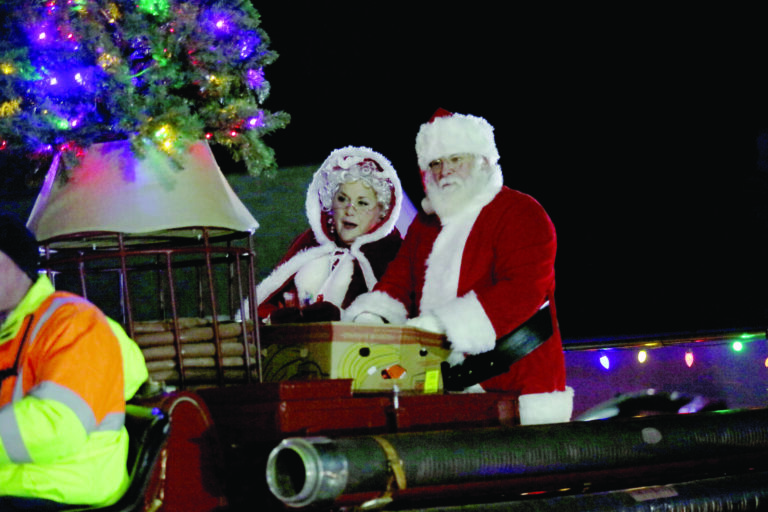Roaring River dive team preps for camera
With high water-flow and a small crew, divers with the KISS Rebreathers team spent the majority of their scheduled May visit to Roaring River Spring working on a planned documentary about their exploration of the cave and spring.
Videographer Tim Bass, with TL Bass Telepictures, of Bentonville, Ark., put the KISS team’s only female diver, Gayle Orner, in the spotlight first. Although Orner confesses she freezes up in front of a video-camera, she did an admirable job of fielding the list of questions prepared by Bass and head diver/CEO of Kiss Rebreathers, Mike Young.
During a prior discussion with Mike Young about adjusting the platforms below the underwater habitats to accommodate the heights of the individual divers, Orner joked that, for her — as a female — it was a treat to even hold onto the habitat, let alone stand in it.
Orner clarified by saying she feels honored to have been invited to join the team of male divers, and doesn’t feel at all like the token female member.
“Gayle was definitely invited for the skills she brings to the table,” Mike Young said.
Those skills include surveying inside the upper cavern.
“We dropped a ‘gold’ survey line from the Colossal Dome, down almost to the restriction on this trip,” Mike Young said. “It’s not perfectly vertical, but it’s a heavier weight of line. When it’s secured, we’ll be able to tie horizontal lines to it on our next trip and extend them to the sides of the cavern to get more accurate measurements of the interior.”
Orner and safety diver Neil Brownlow answered questions for the documentary regarding the difference between the bail-out air tanks and the decompression tanks that divers have access to underwater, as well as the importance of decompression itself.
“As a diver goes deeper in the water, the nitrogen in the air they breathe is compressed into his or her body (in the form of bubbles),” Orner said. “If he ascends back to the surface too quickly, it would be kind of like opening a bottle of Coke after it’s been shaken.”
The need for decompression varies according to the depth of a dive and the amount of time spent at a particular depth.
A rapid ascension, without decompression, could result in serious injury or death to a diver.
“Cold temperatures are an enemy when a diver is decompressing,” Orner said. “Because your blood-flow slows in cold water, it takes longer to off-gas the nitrogen, so no matter how cold you are, you have to decompress a bit longer.”
The rebreathers the KISS team uses allow the divers to reuse the oxygen from their exhaled breaths, so their equipment is much more compact than traditional open-circuit SCUBA gear. However, the rebreathers also require technical expertise to manage that oxygen flow.
“We each wear oxygen-analyzers on a computer attached to our wrists,” Mike Young said. “Our bodies’ oxygen needs diminish the deeper we descend into the water, so we constantly monitor the amount we’re taking in. Too much oxygen can be as toxic as too little oxygen, so we have to stay within a safe range.”
For deep dives, the KISS divers use a tri-mix of gases which include helium, nitrogen and oxygen.
“The helium displaces the nitrogen and reduces its narcotic effect,” Neil Brownlow said.
Brownlow said the use of the bail-out bottles and decompression bottles that are staged at different depths along diving routes.
“We can switch to a bail-out bottle if we develop a problem with our rebreather,” he said. “Then, we can use gas from a decompression (deco) bottle to accelerate our decompression, so we can get to the surface more quickly.”
Individual decompression bottles (or tanks) are clearly marked for various depths and contain the specific mix of gases a diver needs for that depth.
Orner said, during the eight years that she’s owned and used a KISS rebreather, she’s never had to bail out of its use. Young, who engineered the KISS rebreathers, said he hasn’t had to bail out since the testing and experimental stages were completed on the rebreathers over ten years ago.
Young said he pre-mixes most of the gases in the tanks at his manufacturing facility in Fort Smith, Ark. All of the tanks — whether mixed in his facility or elsewhere — are tested for the presence of carbon monoxide prior to being used. Although the analyzer is expensive, it’s a test Young learned the necessity for after losing a friend to carbon monoxide poisoning during a diving expedition in Cozumel many years ago. His friend, Young said, had procured the tank of untested mixed gas from an outside source.
“Carbon monoxide is odorless and tasteless, so its effects can’t be felt until it’s too late,” Young said.
Carbon monoxide can find its way into tanks from the exhaust from fuel-powered generators used for compression, or even from passing automobiles in areas where tanks are being filled. While Young is still haunted by the incident, he says he learned from it and added one more layer of safety to his team’s diving preparations.
Young compares the work of an underwater cave diver to that of an airplane pilot.
“When a skydiver jumps out of an airplane, there’s a bit of chaos that follows – a period of time when they feel out of control,” he said. “As cave divers, we’re more like the pilot of that airplane. We like to be in control of a situation, much like a pilot is. We carefully plan every dive ahead of time and consider contingencies for things that could go wrong, and we try to prepare for them, just in case they do happen.
“Fundamentally, I think our desire to explore is why we love cave-diving. It’s why we do what we do.”
Young’s wife, Sheri, calls herself Mike’s second love, and she’s okay with that.
“Mike doesn’t make a big deal out of his diving plans,” Sheri Young said. “He’s pretty low-key. When he told me he had the opportunity to dive into Roaring River Spring early last year, I didn’t think too much about it. I just asked him if there was indoor plumbing available. He was so matter of fact that I thought it was on par with some of the other diving trips he’s been on in the years since we’ve been married. It was only later I learned that he’d been trying to get permission to dive into the cave for over 10 years.”
Sheri Young, who spent her honeymoon with Mike in a tent during unseasonably cold temperatures on a dive trip to Florida, is grateful for the accommodations and amenities that have been extended to the divers by Roaring River State Park and by Don and Missy Craig, the owners of Roaring River Resort and RV Park.
The Craigs, who have donated cabin space to the divers for their monthly 2022 visits, believe strongly that what the KISS team is doing is important for tourism in the area.
“We know all of their trips have been self-funded and we wanted to help,” Missy Craig said. “We thought about different ideas for fundraisers and ways to contribute and decided donating lodging made the most sense for us.”
Roaring River Resort and RV Park has 46 camping sites, most of which are reserved by annual contracts. The resort, which is open yearround, also has a 22-room hotel and six roomy cabins available. Just up the hill, adjacent to Tim’s Fly Shop, the Craigs are expanding the resort to include 12 studio apartments, which are currently under construction.
The KISS team’s next exploration of Roaring River Spring is scheduled for June 10-12.





